Vermont lawmakers consider banning pesticide class to help insect pollinators
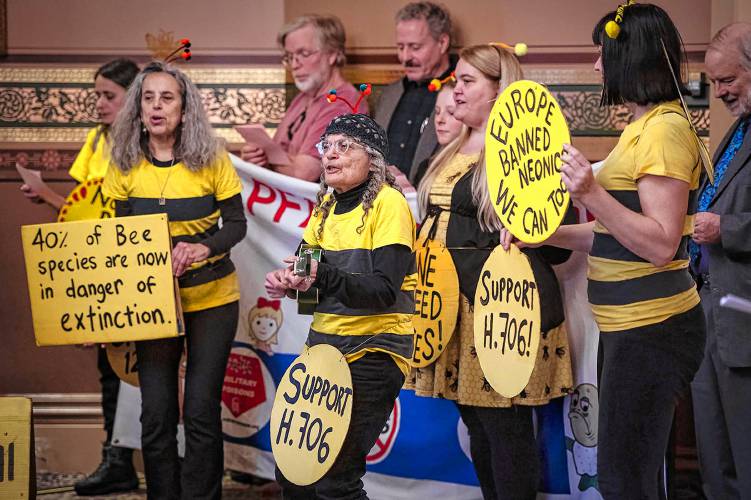
Aro Veno of East Montpelier, Vt., center, leads a singalong at the end of a press conference called to support a bill that would ban neonicotinoid pesticides at the Statehouse in Montpelier on Tuesday, Jan. 30, 2024. (VtDigger - Glenn Russell) —
| Published: 02-05-2024 4:20 PM |
When honeybees gather food from flowers near their hive, they attach beads of pollen and nectar to concave pockets on their legs. The tiny colorful pellets contain residue from all of the plants where the bees have foraged.
For scientists, the pellets are a treasure trove of information about the flowers and plants the bees have come into contact with, and what they’re bringing back to the hive to feed other bees.
“It’s a huge workforce,” Samantha Alger, University of Vermont researcher and director of the Vermont Bee Lab, told state lawmakers last week. “It’s tens of thousands of little bodies that are going out and sampling for us.”
Those pellets may provide answers about why beekeepers are reporting deteriorating health in their colonies. Screens, placed at the entrance to the hives, scrape off the pollen pellets and collect them.
For several years, scientists at the Vermont Bee Lab have been sending the pellets to a laboratory at Cornell University that can detect tiny amounts of various substances.
In 2023, the Vermont Bee Lab sent Cornell more samples than ever before. Out of 61 pollen samples, the lab found 309 instances of 34 pesticides, Alger said.
This research has helped scientists understand that honeybees in Vermont are often exposed to a class of pesticides that is particularly toxic to them in small amounts.
Around 30% of the samples tested positive for those pesticides, called neonicotinoids. Native insect pollinators are exposed to neonicotinoids, too.
Article continues after...
Yesterday's Most Read Articles
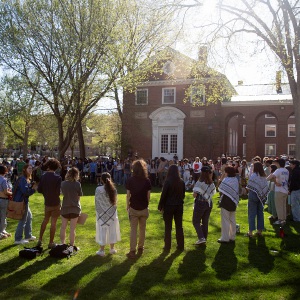 Dartmouth administration faces fierce criticism over protest arrests
Dartmouth administration faces fierce criticism over protest arrests
 Three vie for two Hanover Selectboard seats
Three vie for two Hanover Selectboard seats
 A Look Back: Upper Valley dining scene changes with the times
A Look Back: Upper Valley dining scene changes with the times
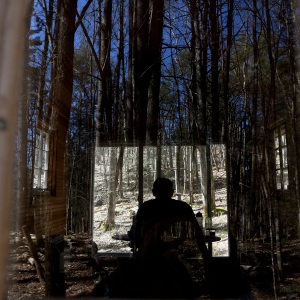 Norwich author and educator sees schools as a reflection of communities
Norwich author and educator sees schools as a reflection of communities
“The pesticides, obviously, are designed to kill insects,” Andrew Munkres, past president of the Vermont Beekeepers Association, told lawmakers earlier this week. “And as a beekeeper, I’m an insect farmer. So I’m trying to raise an animal that other farmers are trying to kill — or, at least, that’s in the same class as other insects that are being killed by pesticides, and so we get caught up as collateral damage.”
It isn’t the first time a debate about neonicotinoids has played out among state lawmakers. Two years ago, a group of lawmakers considered banning use of the chemicals, at least until state officials developed a set of required best management practices. Later, lawmakers removed the ban from the bill before it passed.
Those best management practices, drafted after more than a year of meetings, were published earlier this month by the state’s Agricultural Innovation Board.
Developing the practices has been the 16-member board’s main charge, but the board’s report largely recommends additional research.
This year, however, new circumstances — including new research about exposure to neonicotinoids in Vermont and a new law in New York State that restricts their use — have laid, perhaps, a sturdier foundation for a new bill, H.706, that proposes banning neonicotinoids altogether.
Citing those developments, Rep. David Durfee, D-Shaftsbury, who chairs the House Agriculture, Food Resiliency and Forestry Committee, told VTDigger, “I think there’s more information available, and then that could end up translating to more support.”
Neonicotinoids are a group of insecticides that are designed to control agricultural pests by poisoning the nervous system of insects. In the U.S., they’ve been growing in popularity throughout the last two decades.
Farmers often plant corn and soybeans that are coated with neonicotinoids. As the plants grow, they absorb neonicotinoids into their systems, and flowering plants can express the chemicals in their pollen.
In 2022, 99.6% of corn planted in Vermont came from seeds coated with neonicotinoids, according to data from the Agency of Agriculture, Food and Markets, and 34% of planted soybeans were treated.
Treated seeds are so prevalent that farmers are concerned they wouldn’t be able to find untreated seeds on the market, if lawmakers were to ban neonicotinoids altogether.
Advocates for the ban point to the 2023 New York law, and regulations in Quebec that restricted the use of neonicotinoids in 2019, as evidence that seed manufacturers have started selling untreated seeds and could sell even more in the future.
For farmers, the treatment has historically provided protection against pests, namely the seedcorn maggot, which can cause significant crop losses.
Only about 2% to 3% of the pesticide is absorbed by the plant, while the rest leaches out into the environment, Alger told lawmakers last week. The residues in the soils can be absorbed by other plants that farmers haven’t targeted.
Honeybees are affected by miniscule amounts of neonicotinoids.
Scientists have observed physiological impacts at 0.1 parts per billion of exposure to the neonicotinoid clothianidin.
At 0.9 parts per billion, scientists have seen behavior impacts, such as changes in grooming and reduced immune system strength that can contribute to increased virus levels, Alger said.
A level of 5.12 parts per billion caused changes to the reproductive system, and queens were 34% less likely to survive.
When farmers first started using the seed-coated pesticides, the practice was considered a better alternative to the wide-scale surface pesticide application occurring at the time, which was even less targeted.
“Now we know, (treating seeds) may have been better, but not with broad-scale usage,” said Heather Darby, a soil specialist with the University of Vermont Extension, which provides farmers with technical assistance. “So now, it’s figuring out, what do we do next?”
Some new research raises questions about whether neonicotinoids are effective at all. Researchers at Cornell University planted treated corn and untreated corn, and found little difference in crop yields or damages.
Darby got similar results from a preliminary trial in Alburgh — though she plans to repeat the study over multiple years, and doesn’t believe a single year of data is conclusive.
On average, there was no significant difference in yield in her study, she told VTDigger, but during one planting where she saw seedcorn maggot take flight, the harvest from the untreated corn was significantly less than the treated corn.
“What the data is showing is that there’s not high pest pressure all the time, but when there was really high pest pressure, it did look to have an impact on the yields at that one given time,” she said.
Recently, the federal Environmental Protection Agency researched the benefit of neonicotinoids in soybeans and concluded “that these seed treatments provide little or no overall benefits to soybean production in most situations.”
“Published data indicate that in most cases there is no difference in soybean yield when soybean seed was treated with neonicotinoids versus not receiving any insect control treatment,” the agency states on its website.
Steve Dwinell, director of the Public Health and Agricultural Resource Management division at Vermont’s Agency of Agriculture, is still worried that banning neonicotinoids altogether could cause losses for farmers.
Before neonicotinoids entered the market in the 1990s, crops were badly damaged by pests, he said, and the neonicotinoids seemed to be a solution.
Like Darby’s study, research from Cornell University showed no difference in yields on average, but some individual plantings suffered from pest damage, he said.
As for the times when neonicotinoids did not improve yields, Dwinell wonders whether their widespread adoption may have reduced populations of pests enough that those pests became less of a problem more broadly in a given area, even for plants that weren’t treated with neonicotinoids.
“If you have a widespread use of a particular pest control technology repressing the pest population, then if you plant untreated seed in that setting, the untreated seed’s going to be protected, to some extent, by the use of treated seed everywhere else,” he said.
The impact of neonicotinoids more broadly is concerning to advocates of a ban.
Alger, of the Vermont Bee Lab, presented research to lawmakers showing that dust created by certain types of seed planters spreads beyond agricultural fields and into the broader environment, where it can be taken up by other plants and expressed in their pollen.
Staff from the lab tested flowering plants last summer and found neonicotinoid residue on 22% of their samples, which included flowering plants such as dandelions, apple blossoms, goldenrod and milkweed, the larval host plant of the Monarch butterfly.
The discussion comes as beekeepers have raised alarms about the declining health of their industry (an assessment with which the state Agency of Agriculture does not agree).
While other factors impact honeybees, such as climate change, habitat loss, disease and pests, honeybee keepers say the use of neonicotinoids makes the impacts worse. For example, neonicotinoids damage a bee’s immune system, making it more susceptible to diseases spread by varroa mites, which are a common pest in Vermont.
Munkres, past president of the Vermont Beekeepers Association, and other beekeepers have spoken of persistent and devastating colony losses that have required them to strategically split colonies to make more — an endeavor that’s costly to their business’ bottom line.
Farmers, too, have been impacted by rising production costs and climate change — which sometimes makes pests worse and feed harder to come by. The bill, H.706, which is still in the early stages of the legislative process, proposes exemptions to the neonicotinoid ban in case of emergencies, such as farmers experiencing intense pressure from pests.
The danger with focusing too heavily on neonicotinoids, Dwinell said, is “if you focus on just one part and don’t solve the problem, the bees are still having problems and the native pollinators are still having problems, but at the same time you’ve impacted the ability to produce food, then what have you really done?”
Asked whether he had doubts about any of the facts that have been presented to lawmakers from beekeepers and researchers, Dwinell said he doesn’t and that the agency wants to make decisions based on science.
What to do, then, about the seemingly existential conflict between insect farmers and crop farmers?
“You create an environment where you can do both,” Dwinell said. He said measures such as creating pollinator habitat away from crops treated with pesticides could help.
But beekeepers whose colonies are reportedly suffering are doubtful such a balance is possible with neonicotinoids still in widespread use.
Even if lawmakers move forward with a ban, positive impacts for bees and other pollinators might be far off.
“Where neonicotinoids have been outlawed or banned, do we see an increase in viability for bee colonies?” Rep. Dave Templeman, D-Brownington, asked Alger last week.
“My understanding is, it’s too early to say, because of the persistence of the chemicals,” she responded.

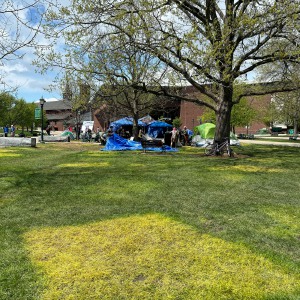 Students take down pro-Palestinian encampment at UVM
Students take down pro-Palestinian encampment at UVM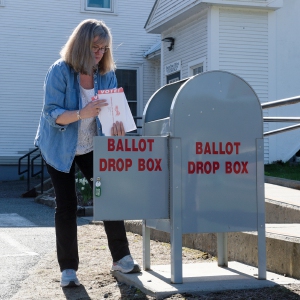 Sharon voters turn back proposal to renovate school
Sharon voters turn back proposal to renovate school
